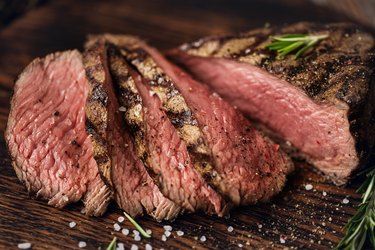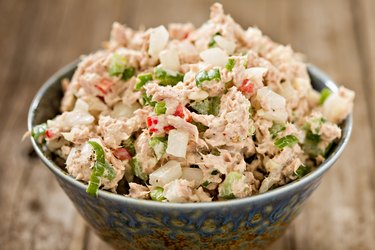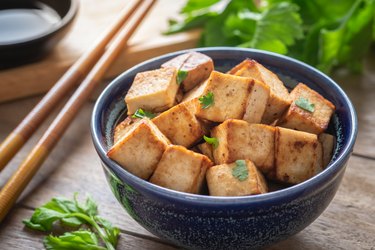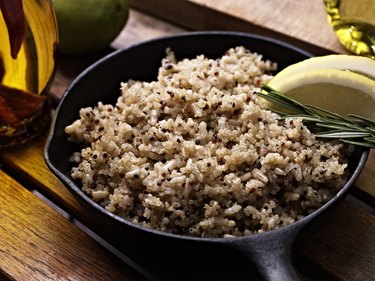Lysine (aka L-lysine) is probably not as top of mind for you like fiber and protein, but this essential amino acid is important for your overall health.
Lysine-rich foods include animal-based foods such as beef, poultry and seafood but the amino acid is also found at lower levels in foods like bananas and other fruits, nuts, popcorn and oatmeal. The body cannot make this amino acid, so it's important to eat foods high in lysine — though most people get enough in their diet naturally, per Mount Sinai. Athletes, burn patients and vegans who don't eat beans may need more than the average person.
Video of the Day
Video of the Day
Some people believe that foods high in lysine and low in arginine can help prevent cold sores. While lysine blocks the activity of arginine (foods high in arginine can promote herpes simplex virus replication and might aggravate cold sores), most experts don't think it improves the healing of cold sores — though supplementation may lower the rate of recurrence or improve symptoms, per Mount Sinai.
Overall, there's not enough convincing evidence that lysine can be used to treat active herpes simplex lesions, per a June 2017 review in Integrative Medicine: A Clinician's Journal. Still, it offers other benefits like helping your body absorb calcium and preventing calcium loss in urine (which could play a role in protecting your bones) and potentially helping your muscle tissue recover after encountering stress, per Mount Sinai.
If you want to increase your intake of lysine naturally, add these high-lysine foods to your shopping cart.
How Much Lysine Do You Need?
The reference daily intake (RDI) for lysine is about 30 milligrams per kilogram (or 2.2 pounds) of body weight for adults, per a classic June 2007 study in The Journal of Nutrition. That equates to about 2,000 milligrams for a person weighing 150 pounds. The foods that contain the most lysine will easily surpass this amount in a serving.
1. Beef: 5,619 mg, 268% RDI

Foods high in lysine typically come from animal sources like beef. You'll get 5,619 milligrams of lysine per 6 ounces of cooked skirt steak. This cut of beef also offers a whopping 49 grams of protein, 114 percent of the daily value (DV) for zinc and more than half of the DV for iron.
Of course, you'll want to be careful not to eat it too frequently, as beef also contains 10 grams of saturated fat. The 2020-2025 Dietary Guidelines recommend limiting your saturated fat intake to no more than 10 percent of total calories per day. Try the protein in these healthy ground beef recipes.
2. Chicken Breast: 5,421 mg, 250% RDI
Again, you tend to find lysine in meat: Lean chicken breast offers 5,421 milligrams of lysine per 6 ounces cooked, plus a bevy of other health benefits. It's considered a healthy source of protein because it has 55 grams of protein but only 1.7 grams of saturated fat and 267 calories.
This protein also provides 99 percent of the DV for selenium, which is important for protecting the body from free radical damage and infection and plays a key role in DNA production, thyroid gland function and reproduction, per the National Institutes of Health (NIH).
Try it in these low-calorie chicken recipes.
3. Pork Chops: 4,687 mg, 223% RDI
Lean pork chops offer 4,687 milligrams of lysine per 6 ounces cooked. They're also a great source of protein with 52.7 grams; but with 4 grams of saturated fat, they may not be as heart-healthy as lean poultry.
Pork chops also provide 41 percent of your DV for phosphorus. This mineral is found in every cell in the human body and is needed to create energy, per the NIH.
4. King Crab: 2,257 mg, 107% RDI
King crab offers 2,257 milligrams of lysine per cooked leg. It's also incredibly rich in vitamin B12 (with 642 percent of the DV) and zinc (with 93 percent of the DV).
Just be mindful if you're watching your sodium: One crab leg contains 1,436 milligrams of sodium (because it's a salt-water species). The Dietary Guidelines call for less than 2,300 milligrams per day, which means one leg gives you more than half of your DV.
5. Canned Tuna: 2,071 mg, 99% RDI

Canned tuna is a nutritious source of lysine with 2,071 milligrams per 3 ounces. It's also a top food high in healthy fats, with 2.7 grams of monounsaturated fat and 2.5 grams of polyunsaturated fat, plus 14 percent of your DV for omega-3 fats.
A diet rich in healthy unsaturated fat instead of saturated fat may improve your blood cholesterol levels, which could in turn lower your risk of heart attack and stroke, per the Mayo Clinic.
Try the fish in these healthy canned tuna recipes.
6. Low-Fat Ricotta Cheese: 1,678 mg, 80% RDI
Ricotta cheese has 1,678 milligrams of lysine per ½ cup. It also provides 25 percent of the DV for calcium and 38 percent of the DV for selenium.
This dairy staple can serve as a delicious pairing for healthy produce like strawberries or bananas.
A vegetarian food high in lysine, canned navy beans contain 1,381 milligrams per cup. They're a good way to fit in lysine with a heart-healthy dose of fiber, with 13.4 grams per cup.
Fiber may help to lower your risk of obesity, diabetes and heart disease, per the Mayo Clinic. Aim to eat 21 to 38 grams of fiber per day.
8. Firm Tofu: 1,113 mg, 53% RDI

If you're looking for vegan foods high in lysine, tofu provides 1,113 milligrams per ½ cup. It's a healthier protein choice than, say, fatty red meat because it has only 1.6 grams of saturated fat.
Fortified tofu is also high in calcium, manganese, copper, selenium, phosphorus and zinc. Try it in these high-protein tofu recipes.
9. Milk: 691 mg, 33% RDI
Skim milk offers 691 milligrams of lysine per cup. This is an example of a food high in lysine but low in arginine as it has only 235 milligrams of arginine. That may make milk a good option if you frequently get cold sores.
10. Soybean Sprouts: 526 mg, 25% RDI
Although you won't often find high levels of lysine in vegetables, raw soybean sprouts are a vegetarian food high in lysine with 526 milligrams per cup. They're also a surprising source of protein, with 9.2 grams per cup.
You'll also get 30 percent of the DV for folate (vitamin B9). Folate is key for making DNA and other genetic material, per the NIH.
11. Green Peas: 502 mg, 24% RDI
Small but mighty, green peas have 502 milligrams of lysine per cup cooked. They also provide nearly half your DV of vitamin A.
Famous for preserving eye health, vitamin A is also important for the immune system and the proper functioning of the heart, lungs, kidneys and other organs, per the NIH.
Try it in these tasty pea recipes.
12. Eggs: 452 mg, 22% RDI
Hard-boiled eggs are high in lysine with 452 milligrams each. They're slightly lower in arginine, with 378 milligrams per egg.
Eggs are also a good source of choline, which makes up the neurotransmitter acetylcholine — a chemical that transmits messages between nerves, per the University of Rochester Medical Center.
Try it in these nutrient-dense (and creative!) egg recipes.
13. Quinoa: 442 mg, 21% RDI

Quinoa provides 442 milligrams of lysine per cup, plus 8.6 grams of protein and 8.8 grams of fiber. It also offers 25 percent of the DV for vitamin C.
Although it's actually a seed, quinoa is classified as a whole grain, per Harvard T.H. Chan School of Public Health. It's a unique plant-based source of protein because it's a complete protein, meaning it provides all nine essential amino acids your body can't make on its own.
Try it in these easy quinoa recipes.
14. Squash and Pumpkin Seeds: 394 mg, 19% RDI
Seeds from squash or pumpkin contain 394 milligrams of lysine per ounce roasted (about 85 seeds). They're also a source of healthy unsaturated fats and plant-based protein.
These seeds provide nearly 30 percent of your DV for zinc. Important for wound healing, zinc also plays a role in your immune system, metabolism function and sense of taste and smell, per the Mayo Clinic.
15. Hemp Seeds: 362 mg, 17% RDI
Hemp seeds provide 362 milligrams of lysine per ounce hulled. They also have 10.8 grams of polyunsaturated fat and 1.5 grams of monounsaturated fats.
Perfect for topping salads or blending into smoothies, hemp seeds contain nearly half of the DV for magnesium and 26 percent of the DV for zinc.
16. Avocados: 265 mg, 13% RDI
Avocados are a fruit high in lysine with 265 milligrams each. They also provide an impressive 14 grams of fiber. Curious what fruits are high in lysine besides avocado? Try apricots, guava, kiwi, mangos and watermelon, per the USDA.
If you're concerned about the lysine-arginine ratio, see below for the foods high in lysine and low in arginine chart.
Foods High in Lysine and Low in Arginine
Serving size | Lysine | Arginine | |
|---|---|---|---|
Yogurt | 1 cup | 762 mg | 255 mg |
Milk | 1 cup | 691 mg | 235 mg |
Cheese | 1 oz. | 370 mg | 174 mg |
Cauliflower | 1 cup | 232 mg | 92 mg |
Papaya | 1 papaya | 195 mg | 78 mg |
Starfruit | 1 starfruit | 95 mg | 26 mg |
Apples | 1 apple | 22 mg | 10 mg |
- Mount Sinai: "Lysine"
- Integrative Medicine: A Clinician’s Journal: "Lysine for Herpes Simplex Prophylaxis: A Review of the Evidence"
- The Journal of Nutrition: "Lysine Requirement through the Human Life Cycle"
- MyFoodData: "Skirt Steak"
- U.S. Department of Agriculture: "2020-2025 Dietary Guidelines"
- MyFoodData: "Lean Chicken Breast (Cooked)"
- National Institutes of Health: "Selenium"
- MyFoodData: "Pork Chops (Lean)"
- National Institutes of Health: "Phosphorus"
- MyFoodData: "Alaskan King Crab"
- MyFoodData: "Canned White Tuna (Oil Packed)"
- Mayo Clinic: "Dietary fat: Know which to choose"
- MyFoodData: "Lowfat Ricotta"
- MyFoodData: "Skim Milk"
- MyFoodData: "Nutrient Ratio Tool"
- Mayo Clinic: "Chart of high-fiber foods"
- MyFoodData: "Firm Tofu"
- MyFoodData: "Soybean Sprouts"
- MyFoodData: "Cooked Green Peas"
- National Institutes of Health: "Vitamin A"
- MyFoodData: "Hard Boiled Eggs"
- University of Rochester Medical Center: "Choline"
- MyFoodData: "Quinoa Cooked"
- Harvard T.H. Chan School of Public Health: "Quinoa"
- MyFoodData: "Roasted Squash And Pumpkin Seeds (With Shells)"
- Mayo Clinic: "Zinc"
- MyFoodData: "Hemp Seeds"
- MyFoodData: "Avocados"
- MyFoodData: "Nutrient Ranking Tool"
- MyFoodData: "Starfruit (Carambola)"
- MyFoodData: "Plain Yogurt"
- MyFoodData: "American Cheese"
- MyFoodData: "Papaya"
- MyFoodData: "Apples"
- MyFoodData: "Plums"